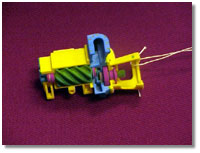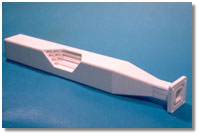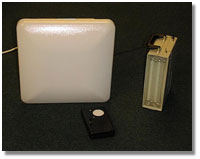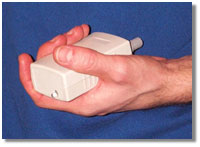| |
***SPECIAL EDITION***
May 6, 2002
Technology Transition: NSF-funded Research To Market
For more information on these science news and feature
story tips, contact the public information officer
listed at (703) 292-8070.
Editor: Josh Chamot
The National Science Foundation (NSF) has a long
history of supporting basic research that leads to
marketable products. Through the Small Business Innovation
Research (SBIR) program alone, NSF awarded more than
300 grants in FY 2001, many resulting in viable technologies.
Grants from other NSF programs produce similar results.
Some technologies serve needs even beyond what the
original investigators had imagined. These news tips
highlight just a few exciting new technologies at
various stages of development and commercialization.
Contents of this News Tip:
Three Dimensional
Printing: Shortcut to the Final Product?
|
For almost two
decades, engineers have been able to create
models directly from computer drawings,
layer by layer, with Solid Freeform Fabrication
technologies. One method, Three Dimensional
Printing (3DPTM) shows promise
for the direct manufacture of goods ranging
from bone grafts to automobile parts.
Emanuel Sachs and colleagues at the Massachusetts
Institute of Technology developed 3DPTM
with support from NSF and other federal
agencies. Currently, five independent
companies are pursuing 3DPTM
applications.
The process is based on the understanding
that any shape can be built from stacked
layers, "Think Pyramids at Giza," said
Sachs. In 3DPTM, the 30 to
200-micron layers are comprised of powdered
ceramic, metal or plastic composites.
Ink jets apply a binder between each subsequent
layer after it is deposited. The resulting
structures can be highly complex, with
complicated internal geometries that would
be difficult to machine using standard
engineering methods.
Direct manufacture applications already
in development include scaffolding for
human tissue grafts, chambered pills that
contain multiple drugs, ceramic molds,
metal parts, filters for power plants
and electronic components. NSF originally
funded the research to address manufacturing
issues, specifically the potential for
prototyping as an all-in-one process,
said George Hazelrigg, a program director
within the NSF engineering directorate.
"Now, it has spinoffs with a big impact
in medicine," particularly because rapid
prototyping is one of the best methods
for manufacturing tissue scaffolding,
he said. [Josh Chamot]
New Approaches to Training Engineers
--
In addition to advancing 3DPTM
technology, Sachs has been developing
a new method for instructing the next
generation of engineers. See the sidebar
for more information and graphics.

This 3DPTM model of the dome
at MIT's Great Hall demonstrates the intricacy
and detail possible with the process.
Photo Credit: MIT 3DP Lab
Select image for larger version
(Size: 13KB)

By using different printer jets to produce
different parts, the 3DPTM
technology is capable of creating color-coded
objects, such as this model of a compressor.
Photo Credit: MIT 3DP Lab
Select image for larger version
(Size: 15KB)
For additional information
on 3DPTM, see: http://www.mit.edu/~tdp/
and
http://www.eng.nsf.gov/engnews/ |
 |

This photo shows a ceramic mold made by
3D Printing and an orthopedic knee casting
poured into a similar mold. The knee casting
has been polished on the back side as
can be seen in the reflection in the mirror.
The casting is made of a medical cobalt
chrome alloy.
Photo Credit: MIT 3DP Lab
Select image for larger version
(Size: 93KB)

This photo shows a family of injection
molding tools made by 3D Printing. The
tool in the lower left corner is approximately
150 mm long. Many of these tools have
conformal cooling channels printed within
them. Such channels lead to far better
temperature control during the injection
molding resulting in faster production
and high quality parts.
Photo Credit: MIT 3DP Lab
Select image for larger version
(Size: 138KB)

This object was printed directly from
a mathematical model and would be extremely
difficult to manufacture by conventional
techniques. It is intended as an illustration
of the geometric capability of 3D Printing.
This model was made by Z Corp., maker
of what are said to be the world's fastest
3D printers.
Photo Credit: Z Corporation
Select image for larger version
(Size: 78KB)

This photo shows a ceramic filter made
by 3D Printing. The cut away shows the
internal passages created as part of the
printing process. 3D Printed filters are
being applied to the clean-up of power
plant emissions.
Photo Credit: MIT 3DP Lab
Select image for larger version
(Size: 101KB)
Larger
versions (Total Size: 460KB) of all
images from this story
 Note
About Images Note
About Images
|
Top of Page
Cinema Sound
Pioneer Receives Academy Award
|
Sound pioneer
Tomlinson Holman, developer of the Lucasfilm
THX Sound System© used
in thousands of movie theaters, recently
received a 2001 Academy Award Certificate
for Technical Achievement recognizing
his more than two decades of research
as an audio engineer at the forefront
of movie theater acoustics and speaker
technology.
In addition to developing THX - the name
derived from Tomlinson Holman's
eXperiment - Holman was lead developer
of George Lucas's state-of-the-art cinema
production facilities Skywalker Ranch
and Skywalker Sound.
Now a professor and researcher at NSF's
Integrated Media Systems Center (IMSC)
at the University of Southern California,
Holman is focusing on the next generation
of cinema sound, especially the 10.2-channel
surround sound system. The 10.2 system,
designed for public and home theater use,
uses 12 speakers in 10 locations, plus
two subwoofers, to create a better sense
of aural immersion.
The range of pitches and loudness for cinema
sound have already exceeded the limits
of human hearing and Holman believes sound
space is the next frontier for audio research.
Under the direction of Chris Kyriakakis
and Holman, NSF's IMSC Immersive Audio
Lab is researching methods to expand these
spatial limits - what Holman calls "the
Manifest Destiny of recorded sound."
"Here is where we can push the scientific
envelope," said Holman of the Immersive
Audio Lab, where he conducts his research.
"Many people who hear of 10.2-channel
sound say its crazy . . . that's exactly
where we should be. Then when they actually
hear it, they're astounded." [Josh
Chamot]
For additional information, see: http://imsc.usc.edu |
 |

The graphic depicts a soldier in an immersive
training environment. The environment
uses 10.2 sound and high-resolution imagery
to accurately simulate the acoustic and
visual space of a combat setting.
Photo Credit: Image is property of
the Integrated Media Systems Center (IMSC).
Image courtesy of IMSC and DARPA.
Select image for larger version
(Size: 119KB)

Setup of the 10.2-channel surround sound
system, an immersive audio system being
developed at NSF's Integrated Media Systems
Center at the University of Southern California.
Photo Credit: Image is property of
the Integrated Media Systems Center
Select image for larger version
(Size: 121KB)
Larger
versions (Total Size: 270KB) of all
images from this story
 Note
About Images Note
About Images
|
Top of Page
Harnessing
Fluorescent Light Flicker to Communicate Data
 |

Fluorescent lights used in the Talking
LightsTM system.
Photo Credit: Image courtesy of Talking
LightsTM
Select image for larger version
(Size: 96KB)

Handheld receiver used in certain applications
of the Talking LightsTM system.
Photo Credit: Image courtesy of Talking
LightsTM
Select image for larger version
(Size: 98KB)
Larger
versions (Total Size: 230KB) of all
images from this story
 Note
About Images Note
About Images
|
 |
 |
Engineers have developed a system to turn a fluorescent
light into a transmitter by controlling the rate of
its flicker. The system, known as Talking LightsTM,
is the first to use the frequency of the incoming
electric current to transmit both analog and digital
information.
MIT engineers Roderick Hinman (who has an NSF Small
Business Innovation Research (SBIR) grant), and Steven
Leeb (who has an NSF CAREER grant) developed the Talking
LightsTM technology with additional support
from other federal agencies. Now in the testing and
prototype phases, the system may have applications
for disability assistance, education and national
security.
Talking LightsTM uses existing fluorescent
light fixtures, replacing only the light's ballast
with the ARCLightTM ballast to control
the frequency of the electric current. In a demonstration
at MIT, Leeb placed a receiver and speakers at one
end of the room and a Talking LightsTM
fluorescent light at the other. When he turned on
the light, Handel's Hallelujah Chorus played from
the speakers, with all audio data arising solely from
the light's imperceptible flicker.
"The concept of this communication system is highly
innovative," said NSF's Sara Nerlove, an SBIR program
manager. "Unlike other specialized communications
systems, it does not need to generate and radiate
a carrier signal. Instead, it takes advantage of existing
installations that generate and radiate light."
Leeb and his colleagues call Talking LightsTM
a dual-use, local area wireless system because the
original purpose of the device - illumination - persists
while information is transmitted. Because fluorescent
lights are ubiquitous and the modifications are minimal,
the researchers believe Talking LightsTM
may have a variety of uses as a cost-effective local
communications system.
In several recent and ongoing clinical tests, the researchers
are helping visually impaired individuals and mentally
impaired hospital patients navigate hallways by transmitting
location information from overhead lights to participants'
headsets. Talking LightsTM devices are
also being qualified for military use, such as stationary
transmitters that communicate minefield information
to hand-held receivers. [Josh Chamot]
For more information, see: http://www.talking-lights.com
Top of Page
Artificial
Intelligence as Tutor
|
Inspired by the methods of his rural Kentucky
high-school chemistry teacher, an NSF-supported
researcher has developed an artificial
intelligence tutoring software that helps
students confront complex science questions.
In 1998, chemist Benny Johnson founded
Quantum Simulations, Inc. with high school
mentor Dale Holder and colleague Rebecca
Renshaw to create highly interactive tutoring
software for the sciences.
Many pre-existing tutoring programs store
information in a database and do not allow
for student input beyond multiple choice
answers or simple responses. In contrast,
the Quantum Tutors "converse" with students,
said Johnson, "providing real-time feedback
. . . Tutors respond to student questions,
give hints, show correct next steps and
even explain why a step is correct or
incorrect using scientific principles."
Students can enter any problem and related
work, and the Quantum Tutoring Engines
will understand and analyze all of the
material. Any mistakes are confronted
individually, and the student and the
"tutor" provide information to each other
throughout the learning exercise.
"At each step of a solution, the computer
is able to generate a set of questions
that students can ask," said Sara Nerlove,
a program manager in NSF's SBIR program.
"This capability of Quantum Solutions'
technology provides a degree of apprenticeship
that goes beyond that available in a conventional
tutor."
Quantum recently partnered with Holt, Rinehart
and Winston (HRW) to include AI tutors
as an Internet component in high school
chemistry, physical science, and integrated
science course materials, and middle school
physical science materials. According
to Renshaw, HRW is the first textbook
publishing company to utilize AI technology
for chemistry and physical science.
Quantum has been receiving NSF funding
since 2000 through the SBIR program. Along
with additional support from the Department
of Education and various private awards,
Johnson and Holder have developed six
chemistry tutors based on their artificial
intelligence technology. [Josh Chamot]
For additional information, see: http://www.quantumsimulations.com/home.html
|
 |

This screen capture demonstrates the HRW/Quantum
product for Balancing Equations. The product
has an "Ask Questions" feature - a pull
down menu that displays questions that
change with each step the student takes.
Photo Credit: Holt, Reinhart, and
Winston/Quantum Simulations, Inc.
Select image for larger version
(Size: 572KB)

This screen capture demonstrates a key
software feature that allows students
to enter their own work throughout the
tutoring process. The Quantum Tutor interprets
the individual work and guides the individual
to a completed solution.
Photo Credit: Holt, Reinhart, and
Winston/Quantum Simulations, Inc.
Select image for larger version
(Size: 515KB)
Larger
versions (Total Size: 1.1MB) of all
images from this story
 Note
About Images Note
About Images
|
Top of Page
Real-Time Chemical
Detectors
A new laser technology may help research investigators
by rapidly detecting and identifying trace amounts
of gas and chemicals. Scientists funded by NSF spent
more than a decade developing the portable sensing
technology called cavity ring-down spectroscopy (CRDS),
which is expected to reach the commercial market this
year.
CRDS is a promising technique to detect leaks from
stored chemicals, contamination in ground water and
vapor from concealed explosives or chemical warfare
agents. Other potential uses include testing for impurities
in the manufacture of electronic products and in diagnostic
medical tests such as analyzing a patient's breath.
The ability to monitor a network of sensors in real
time via the Internet make it useful for monitoring
environmental conditions at both large industrial
plants and in neighborhoods.
The miniature sensors use fiber optics, pulsed lasers
and spectroscopy to identify a gas by measuring its
absorption of light. Light is bounced back and forth
between mirrors at each end of a cavity (the ringing
process), and the decay rate of the light (ringing
down) identifies the substance in the cavity.
Anthony O'Keefe of Los Gatos Research, Palo Alto, Calif.,
was instrumental in developing the technique. His
company is currently developing a commercial application
for chemical storage facilities with an NSF small
business grant. Other scientists--including NSF grantees
Richard Saykally of the University of California-Berkeley,
Kevin Lehmann of Princeton University, and Richard
Zare of Stanford University--have also helped develop
applications. [Amber Jones]
For additional information, see: http://www.lgrinc.com/
Top of Page
|
|













